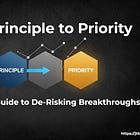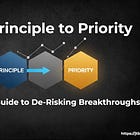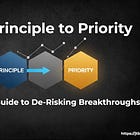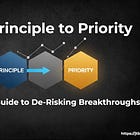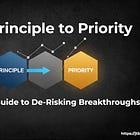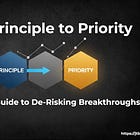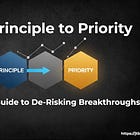From Principle to Priority: Chapter 7
The Heatmap: Quantifying the Underserved Opportunity
This 10-article series is designed to disrupt common thinking about innovation. It provides a new framework to help you tear down old methods and invest more efficiently in breakthrough ideas. Please share!
STAGE 2 - THE OPTION TO VALIDATE (Opportunity Sizing)
We have successfully defined the what and the how. We have a complete, ten-step Job Map detailing the chronological process a CFO must execute, and we have a comprehensive list of 100+ Customer Success Statements (CSS) defining the “perfect” outcome for each step.
We have built our quantitative instrument. Now, we must use it to find the opportunity. This is the moment we purchase our Option to Validate.
The goal is to transform our list of 100+ needs into a clear, data-driven, rank-ordered list of priorities. We must find the “hotspots” on our Job Map—the needs that are critically important to our customers but are very poorly served by all current solutions. This is the “heatmap” of the opportunity.
The Problem: “Stated Importance” Is a Trap
The most common way to do this is fatally flawed. The typical approach is to survey 150 customers and ask them to rate each of the 100+ statements on two scales:
“How important is this to you?” (1-5 scale)
“How satisfied are you with your current solution?” (1-5 scale)
Then, these numbers are plugged into a formula like
Opportunity = Importance + (Importance - Satisfaction).
This seems logical, but it’s a trap. The problem is that “stated importance” is an unreliable, subjective metric. When asked, people will say everything is important. This “importance inflation” makes it impossible to find the true priorities. You end up with a list where 80 out of 100 needs look like “high priority,” which is the same as having no priorities at all.
We need a more objective, statistically-sound method. We need a way to find true importance, not just stated importance.
The Solution: A Two-Part Framework for Prioritization
The From Principle to Priority methodology provides a robust, two-part framework. It gives us a primary score to rank the entire market and a secondary analysis to find specific, high-value segments within it.
Part 1: The “Objective Need Score” (The Market-Wide Rank)
This is our main tool for ranking all 100+ needs. It’s a simple formula:
Objective Need Score = Impact x Urgency
Let’s break this down in simple, step-by-step terms.
Step 1: Measuring “Urgency” (The Gap Score)
This tells us how dissatisfied the market is. We use the same two questions from the old model (Importance 1-5 and Satisfaction 1-5), but we analyze them in a better way.
Survey: We survey our 150 CFOs. For each CSS, we have an Importance score and a Satisfaction score.
Find the “Top-Box”: Instead of averaging the scores (which is bad statistics), we count percentages. We calculate the “% Important”—the percentage of CFOs who gave a high score (a 4 or 5). Let’s say 80% said “Minimize the time to aggregate data” is important.
Find the “Top-Box” Gap: We then calculate the “% Satisfied”—the percentage who gave a high score (a 4 or 5) for their current satisfaction. Let’s say only 30% are satisfied.
Calculate Urgency: The “Gap Score” (G) is the difference: 80% - 30% = 50%. This 50% gap is a clear signal of high market-wide “Urgency” or pain.
Step 2: Measuring “Impact” (Derived Importance)
This is the secret weapon. This tells us the true, objective importance of a need, rather than what customers said was important.
Add One Question: At the very end of our survey, we add one more question: “Overall, how satisfied are you with getting this entire job done?“ (on a 1-5 scale). This is our “anchor” metric.
Run Correlation: We now use simple statistics (a Pearson correlation) to find the hidden connections. For each individual success statement (like “Minimize time to aggregate data”), we ask the computer: “How much does a person’s satisfaction with this one statement affect their overall satisfaction with the entire job?”
Get the “Impact” Score (r): This gives us a score from 0 to 1, which is our “Impact” or “Derived Importance” (r).
A high score (e.g., r = 0.75) means this one need is a massive driver of their total success. When they are happy with this, they are happy overall. This is a critical priority.
A low score (e.g., r = 0.10) means this need is a “nice-to-have.” Even if they said it was important, the data shows it doesn’t actually drive their overall success. We can safely de-prioritize it.
Step 3: Calculate the Final Score
Now we just multiply our two numbers.
Objective Need Score = Impact (r) x Urgency (G)Objective Need Score = 0.75 x 50% = 37.5
We repeat this calculation for all 100+ success statements. The statement with the highest final score is our #1, data-driven, objectively-proven market opportunity. We sort this list from highest to lowest, and we have our heatmap. This is our master innovation roadmap.
Part 2: The “Expert Analysis” (Finding Niche Opportunities)
The Objective Need Score gives us our main, market-wide rank. Now we can put on our “expert” goggles and dig deeper to find specific, high-value segments. This is where we use the “Percentages and Ranks” analysis.
This is a secondary analysis. We are no longer ranking—we are characterizing the opportunities.
Metric A: Finding “Acute Pain” (The % Critically Underserved)
This filter finds the customers who are desperate for a solution.
How to Calculate: For each success statement, we count the percentage of all respondents who rated it Very Important (4 or 5) AND ALSO rated their Satisfaction Very Low (1 or 2).
Strategic Value: Let’s look at our list. “Minimize the number of steps required to assemble a report for a specific audience (e.g., for the board vs. a regulator)” might be #15 on our main list (a low priority). But when we run this filter, we find that 45% of CFOs are “Critically Underserved” on this one need.
The Insight: We just found a perfect, high-pain, and profitable niche opportunity. An entire segment of the market is desperate for this one thing. We could launch a targeted feature or even a separate product just for them.
Metric B: Finding “Consistent Frustration” (The % Top Personal Priority)
This filter finds the needs that are a constant, top-of-mind annoyance for the most people.
How to Calculate: For each individual CFO, we calculate their personal gap score (Importance - Satisfaction) for all 100+ needs. We then find their personal “Top 3” most painful needs. Finally, we count, for each need, what percentage of CFOs had it in their personal Top 3.
Strategic Value: Let’s look at our list again. “Minimize the number of steps required to distribute a final report to all required stakeholders” might be #2 on our main list (a high priority). When we run this filter, we find it’s in 55% of all CFOs’ “Top 3” list.
The Insight: This isn’t a niche problem; it’s a broad, consistent annoyance for the majority of the market. This confirms its high rank and tells us that solving this “quality of life” issue will be a huge win that impacts everyone.
Conclusion: The Complete, Data-Driven Roadmap
By following this two-part framework, we have successfully purchased our Option to Validate. We are no longer guessing.
We have our Objective Need Score, a statistically-sound, market-wide ranking of all 100+ needs. This is our master “Top 10” list of what to build.
We have our Expert Segmentation Analysis, which tells us the character of each opportunity—which ones are “Core Problems,” which are “Broad Annoyances,” and which are “Niche Opportunities.”
We now have a true heatmap of the entire job. We have a prioritized backlog for innovation, backed by objective data. We have transformed a qualitative hunch into a quantitative, defensible business case, all without writing a single line of code.
If you’re in love with the idea of factor and cluster analysis, have a field day. This is far more straight-forward and easier to explain to executive decision-makers.
We are now, finally, ready to move to our third and final bet: the Option to Build.
Guide to the Series



